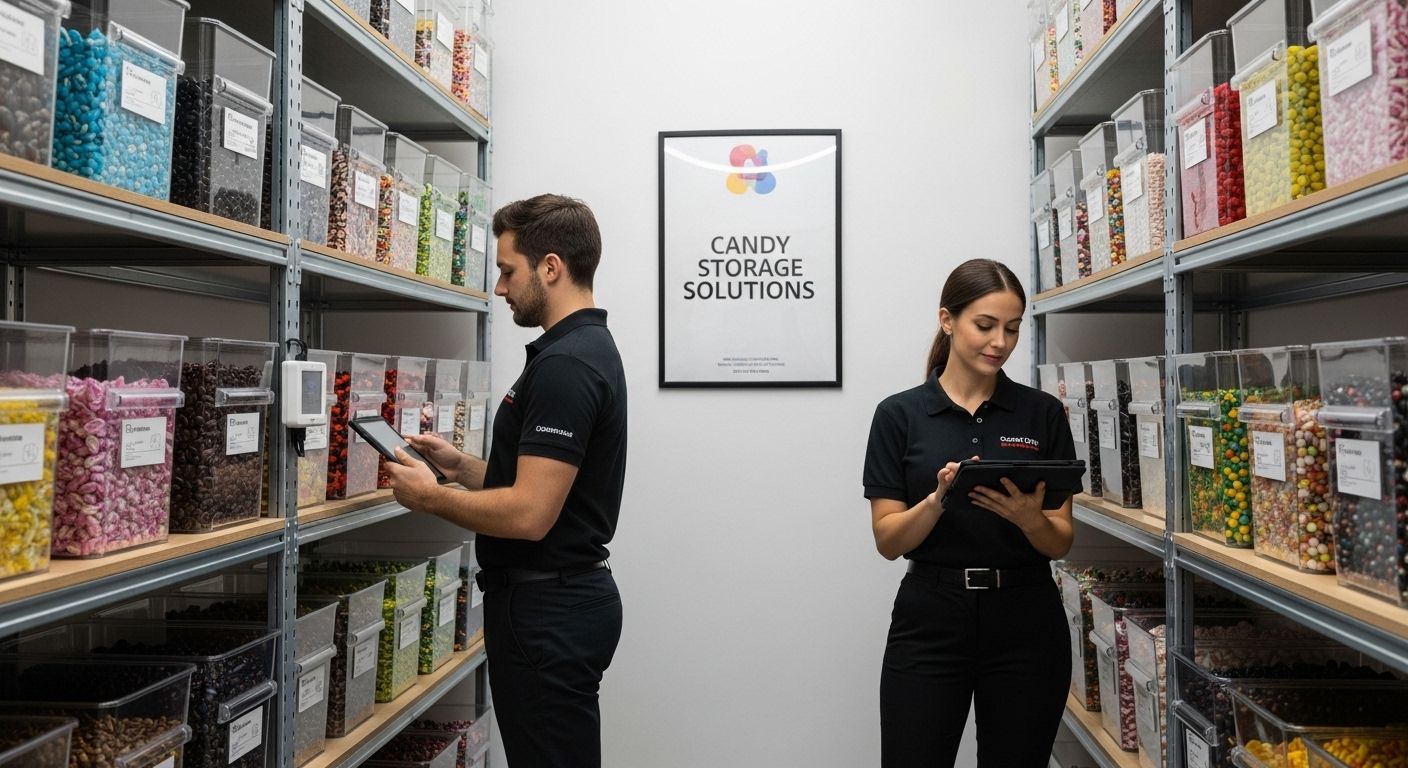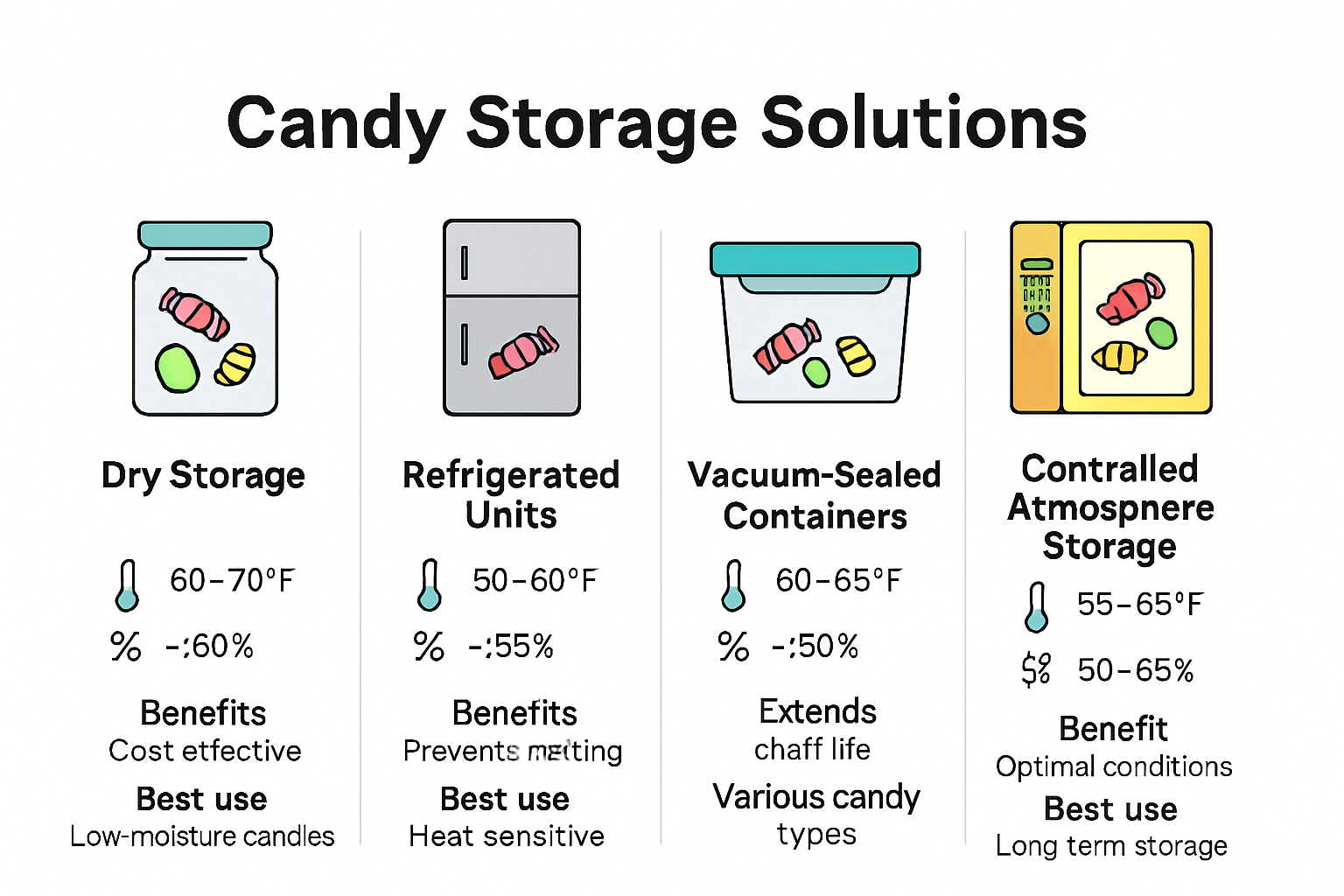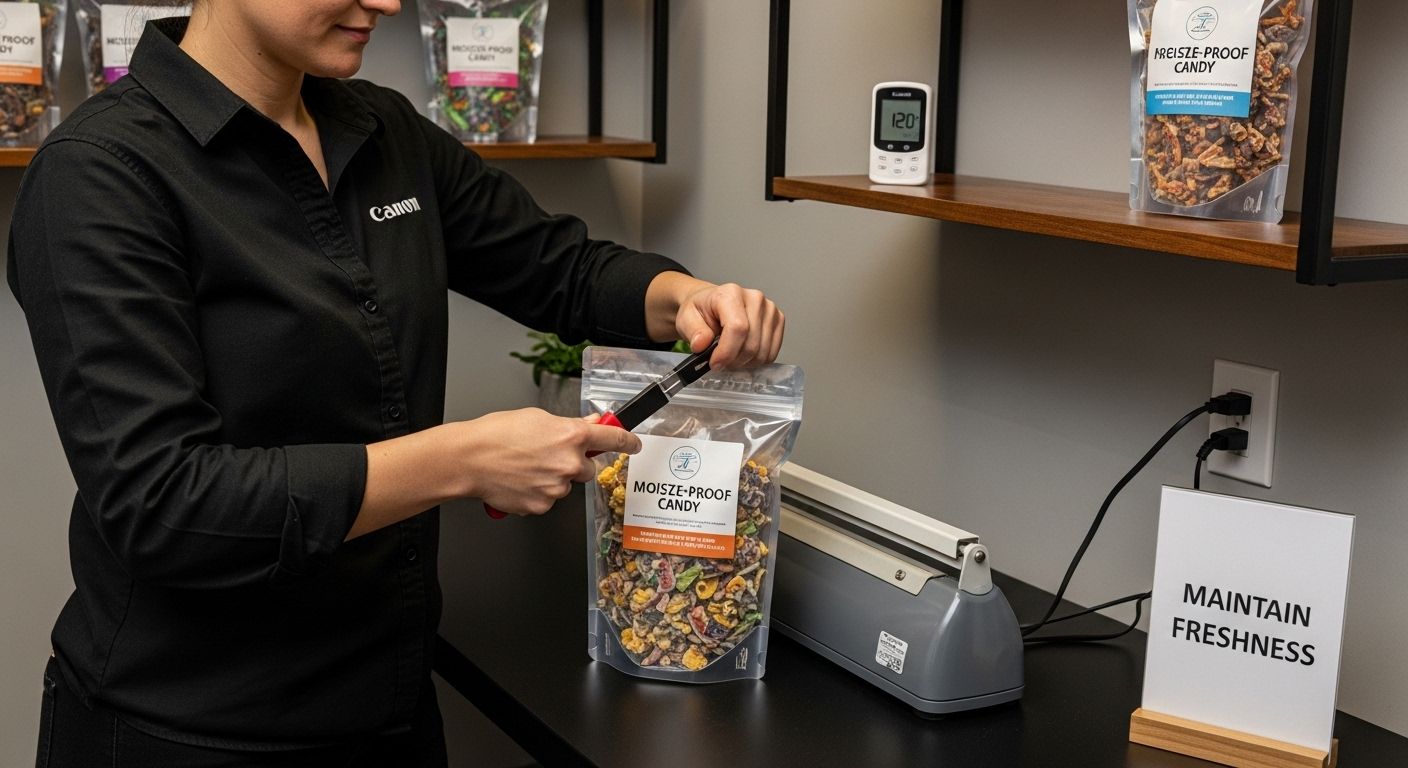Les bonbons peuvent paraître simples à l'extérieur et amusants à manger, mais la science qui permet de les conserver frais est étonnamment complexe.

La plupart des gens ignorent qu'une mauvaise conservation des bonbons peut engendrer des pertes considérables, les entreprises risquant des milliers d'euros à cause du gaspillage et du mécontentement des clients. Le plus frappant, c'est qu'une simple variation de température ou d'humidité peut ruiner des lots entiers . Cette lutte invisible pour la préservation des confiseries est la véritable raison d'être des solutions de conservation de pointe actuelles.
Table des matières
- Que sont les solutions de stockage de bonbons et quelle est leur importance ?
- La science de la conservation des bonbons : pourquoi un stockage adéquat est important
- Solutions de rangement pour bonbons : comment choisir la bonne option ?
- Meilleures pratiques pour préserver la fraîcheur des bonbons stockés
- L’impact d’un stockage efficace des bonbons sur les ventes et l’expérience client
Résumé rapide
| Emporter | Explication |
|---|---|
| Maintenir une température et une humidité idéales | Conservez les bonbons entre 55 et 70 degrés Fahrenheit et entre 50 et 55 % d'humidité pour éviter toute dégradation de leur qualité. |
| Évitez l'exposition directe au soleil et les variations de température. | Protégez les bonbons de la lumière et des variations brusques de température afin de préserver leur qualité et leur texture. |
| Utiliser des matériaux d'emballage spécialisés | Mettre en œuvre des emballages résistants à l'humidité et hermétiques pour protéger contre les contaminants extérieurs et prolonger la durée de conservation. |
| Surveillez régulièrement les conditions de stockage | Utiliser des systèmes de surveillance numérique pour garantir des conditions environnementales constantes et optimales pour les bonbons stockés. |
| Investissez dans des solutions de stockage avancées | En fonction du type de bonbon, envisagez des unités à température contrôlée et des contenants sous vide. |
Que sont les solutions de stockage de bonbons et quelle est leur importance ?
Les solutions de conservation des confiseries regroupent des systèmes et des méthodes spécialisés conçus pour préserver la qualité, la fraîcheur et la sécurité des produits de confiserie tout au long de leur cycle de vie. Ces approches globales vont au-delà du simple emballage et englobent le contrôle de l'environnement, la gestion de la température, la régulation de l'humidité et des techniques de manipulation stratégiques qui protègent les confiseries de toute dégradation.
Comprendre les composantes essentielles du stockage des bonbons
Les solutions de conservation efficaces pour les confiseries intègrent plusieurs éléments essentiels pour préserver l'intégrité du produit. La température joue un rôle primordial dans la conservation de la qualité des confiseries. La plupart des chocolats et des confiseries à base de sucre nécessitent une température de conservation constante entre 13 et 21 °C (55 et 70 °F), avec un taux d'humidité contrôlé autour de 50 à 55 %. Des variations en dehors de ces plages peuvent entraîner des dommages importants, tels que le blanchiment du chocolat, la cristallisation du sucre ou des modifications de la texture.
Les principaux objectifs des solutions professionnelles de stockage de confiseries sont les suivants :
- Prévention de la contamination par l'humidité : Protéger les bonbons de l'humidité qui peut entraîner la dégradation du sucre
- Stabilisation de la température : Maintien de conditions environnementales constantes
- Préservation structurelle : Prévenir la déformation physique ou la séparation des ingrédients
Pourquoi les entreprises ne peuvent pas négliger le stockage adéquat des bonbons
Pour les entreprises du secteur de la confiserie, le stockage est essentiel et non une option. Selon la National Confectioners Association , un stockage inadéquat peut engendrer des pertes financières considérables. Les bonbons mal conservés peuvent se dégrader rapidement, ce qui réduit leur durée de conservation, altère leur goût et risque de provoquer l'insatisfaction des clients.
Les solutions de stockage professionnelles répondent également aux exigences essentielles en matière de sécurité alimentaire. Les fabricants et les détaillants de confiseries doivent mettre en œuvre des stratégies de stockage qui préviennent la contamination, protègent contre les infestations de nuisibles et garantissent la traçabilité des produits. Cela nécessite des investissements dans des équipements de stockage spécialisés, des systèmes de surveillance et du personnel formé qui comprend les exigences spécifiques aux différents types de confiseries.
Découvrez nos solutions d'emballage spécialisées pour les confiseries, qui aident les entreprises à maintenir une qualité optimale de leurs produits, de la production à la livraison au consommateur.
La science de la conservation des bonbons : pourquoi un stockage adéquat est important
La conservation des confiseries est un processus scientifique complexe qui repose sur la compréhension des interactions chimiques entre les ingrédients, les conditions environnementales et les techniques de stockage. La structure moléculaire des confiseries les rend particulièrement sensibles aux variations environnementales, ce qui exige des approches scientifiques précises pour préserver leur qualité et leurs caractéristiques sensorielles d'origine.
Composition chimique et vulnérabilité
Les produits de confiserie contiennent des ingrédients sensibles comme les sucres, les matières grasses et l'humidité, qui subissent de subtiles transformations lorsqu'ils sont exposés à des conditions de stockage inappropriées. Les molécules de sucre peuvent recristalliser, les matières grasses s'oxyder et les structures protéiques se dénaturer, entraînant des modifications importantes de la texture, de la saveur et de l'intégrité globale du produit. La température et l'humidité sont les principaux facteurs externes qui déclenchent ces transformations moléculaires .
Les principales vulnérabilités moléculaires dans la conservation des bonbons comprennent :
- Recristallisation du sucre à des températures incohérentes
- L'oxydation des graisses entraîne des saveurs rances
- Dégradation de la structure protéique affectant la texture
- La migration de l'humidité entraîne des changements structurels
La physique de la dégradation des bonbons
Selon l'Institut de recherche en sciences alimentaires , la dégradation des bonbons obéit à des principes physiques prévisibles. Différents types de confiseries subissent des processus de dégradation moléculaire spécifiques. Le chocolat, par exemple, développe un voile blanc lorsque le beurre de cacao se sépare sous l'effet des variations de température. Les bonbons gélifiés perdent de leur élasticité lorsque leur taux d'humidité change, tandis que les bonbons durs deviennent collants ou granuleux en milieu humide.
Les solutions de stockage professionnelles s'appuient sur des principes scientifiques pour contrer ces processus de dégradation naturels. Des environnements de stockage spécialisés créent des microclimats stables qui minimisent les mouvements moléculaires, empêchant ainsi les interactions chimiques susceptibles d'altérer la qualité des confiseries. Ceci implique un contrôle précis de la température, une régulation de l'humidité et une protection contre l'exposition à la lumière.
Le tableau suivant récapitule les problèmes de qualité des bonbons les plus courants causés par un stockage inadéquat et les solutions de stockage professionnelles qui y remédient.
| Problème de qualité | Cause | Impact sur les bonbons | Méthode de prévention |
|---|---|---|---|
| Fleur de chocolat | fluctuation de température | Décoloration blanche de la surface | Température constante, réfrigération |
| Cristallisation du sucre | Variations d'humidité et de température | Texture granuleuse | Contrôle de l'humidité, emballage hermétique |
| Migration de l'humidité | humidité élevée | Perte de texture/structure | Emballage barrière contre l'humidité, contrôle de l'humidité relative |
| Oxydation des graisses | Exposition à l'air | Saveur rance | Matériaux absorbant l'oxygène, joint sous vide |
| Déformation physique | exposition à la chaleur, manipulation | Bonbons difformes | Emballage structurel, contrôle climatique |
Découvrez nos techniques de conservation avancées qui tirent parti des connaissances scientifiques de pointe pour maintenir la qualité des bonbons de la production à la consommation.
Solutions de rangement pour bonbons : comment choisir la solution adaptée ?
Les solutions de stockage des confiseries ne sont pas des stratégies universelles, mais des systèmes spécialisés adaptés aux caractéristiques spécifiques des produits, aux besoins des entreprises et aux exigences du secteur. Comprendre les subtilités des différentes options de stockage est essentiel pour préserver la qualité des produits, prolonger leur durée de conservation et garantir le respect constant des normes de sécurité alimentaire.
Systèmes de stockage à contrôle environnemental
Les solutions de stockage à environnement contrôlé représentent l'approche la plus sophistiquée en matière de conservation des confiseries. Ces systèmes assurent une régulation précise de la température, de l'humidité et de l'atmosphère afin de prévenir toute dégradation moléculaire. Les unités réfrigérées et climatisées de qualité commerciale permettent une gestion fine des conditions de stockage, permettant ainsi aux entreprises de créer des microenvironnements qui protègent les confiseries délicates.
Les principales caractéristiques des systèmes de contrôle environnemental avancés sont les suivantes :
- Gestion précise de la plage de température (55-70 degrés Fahrenheit)
- Mécanismes de contrôle de l'humidité (50-55 % d'humidité relative)
- technologies de circulation et de filtration de l'air
- Capacités de surveillance et d'enregistrement numériques
Catégories de stockage spécialisées
Selon le Food Packaging and Storage Institute , les solutions de stockage de confiseries peuvent être classées en plusieurs types spécialisés en fonction des exigences du produit :
- Unités de stockage à sec : Idéales pour les bonbons stables à température ambiante et à faible teneur en humidité.
- Compartiments réfrigérés : indispensables pour les confiseries à base de chocolat et de crème.
- Contenants sous vide : préviennent l'oxydation et la contamination par l'humidité
- Stockage en atmosphère contrôlée : Systèmes avancés qui modifient la composition interne des gaz
Chaque catégorie de stockage répond à des défis de conservation spécifiques, protégeant contre les mécanismes potentiels de dégradation de la qualité tels que la cristallisation du sucre, le blanchiment des graisses et les changements de texture.
Pour aider les entreprises à choisir la méthode de conservation la plus adaptée, voici une comparaison des différentes catégories de solutions de stockage de confiseries mentionnées dans ce guide.
| Type de solution de stockage | Convient pour | Caractéristiques principales | Principal avantage en matière de préservation |
|---|---|---|---|
| Unités de stockage à sec | Bonbons à faible teneur en humidité et longue conservation | Contrôle simple de la température ambiante et de l'humidité | Protège de l'humidité et des insectes |
| Compartiments réfrigérés | Chocolat, confiseries à base de crème | Régulation de la température, fluctuations minimales | Empêche le blanchiment et l'altération du chocolat |
| Contenants sous vide | Bonbons variés sensibles à l'oxydation/à l'humidité | Joint étanche à l'air, souvent utilisé avec des barrières anti-humidité | Empêche l'oxydation et l'infiltration d'humidité |
| Unités à atmosphère contrôlée | Confiseries de grande valeur et délicates | Régule avec précision les gaz, la température et l'humidité | Préserve la fraîcheur et la texture |

Découvrez nos stratégies de conservation innovantes, conçues pour maintenir les plus hauts standards de qualité et de fraîcheur de nos confiseries.
Meilleures pratiques pour préserver la fraîcheur des bonbons stockés
Préserver la fraîcheur des confiseries exige une approche stratégique alliant connaissances scientifiques, gestion environnementale rigoureuse et techniques de conservation proactives. Les entreprises doivent mettre en œuvre des stratégies globales pour protéger leurs produits de confiserie de la dégradation, tout en garantissant une qualité constante et la satisfaction des consommateurs.
Stratégies de contrôle de la température et de l'humidité
Des conditions environnementales stables sont essentielles à une bonne conservation des confiseries . Les solutions de stockage professionnelles exigent une attention méticuleuse portée à la température et à l'humidité. La plupart des confiseries nécessitent un environnement de stockage compris entre 13 et 21 degrés Celsius (55 et 70 degrés Fahrenheit), avec une humidité relative maintenue entre 50 et 55 %. Toute fluctuation en dehors de ces plages précises peut entraîner des modifications moléculaires et altérer la qualité du produit.
Les principes clés de la gestion environnementale comprennent :
- Éviter l'exposition directe au soleil
- Minimiser les variations de température
- Utilisation d'unités de stockage climatisées
- Mise en place de systèmes de surveillance réguliers
Techniques d'emballage et de protection
Selon l' International Food Packaging Institute , les emballages de pointe jouent un rôle essentiel dans la conservation des confiseries. Des matériaux d'emballage spécialisés créent des barrières protectrices contre l'humidité, l'oxygène et les contaminants extérieurs . Les contenants sous vide, les emballages résistants à l'humidité et les techniques de déplacement de gaz inerte permettent d'allonger considérablement la durée de conservation des produits et de préserver leurs qualités organoleptiques.
Les considérations essentielles en matière d'emballage comprennent :
- technologies d'absorption d'oxygène
- Matériaux barrière contre l'humidité
- Mécanismes d'étanchéité à l'air
- Conceptions d'emballage opaques
Découvrez nos techniques de conservation avancées pour maintenir une qualité optimale des bonbons tout au long du stockage et de la distribution.
L’impact d’un stockage efficace des bonbons sur les ventes et l’expérience client
Un stockage efficace des confiseries va bien au-delà de la simple conservation ; il influence directement la performance de l’entreprise, la perception du client et la réputation de la marque. La relation complexe entre les pratiques de stockage et la satisfaction du consommateur représente un élément stratégique essentiel pour les entreprises de confiserie qui visent une croissance durable et une compétitivité accrue sur le marché.
Perception de la qualité et confiance envers la marque
La confiance des consommateurs repose sur une qualité de produit constante , qui commence par des stratégies de stockage rigoureuses. Lorsque les bonbons conservent leurs qualités organoleptiques d'origine (texture, saveur et aspect), les clients font confiance à la marque. Les produits mal conservés présentent des défauts visibles, comme un blanchiment du sucre, des changements de couleur ou une dégradation de la texture, autant de signaux d'alarme immédiats pour les consommateurs exigeants, indiquant une qualité compromise.
Les principaux facteurs influençant la perception du client sont les suivants :
- Aspect visuel des produits stockés
- Profils de saveur constants
- Intégrité structurelle des bonbons
- Présentation de l'emballage
Implications économiques des pratiques de stockage
Selon le Retail Food Industry Research Center , des solutions de stockage adéquates ont un impact direct sur la rentabilité d'une entreprise. Des techniques de conservation efficaces minimisent le gaspillage de produits , réduisent les pertes sur stocks et optimisent la gestion des stocks. Les entreprises qui mettent en œuvre des stratégies de stockage sophistiquées peuvent espérer des économies substantielles grâce à une durée de conservation prolongée et une réduction des pertes.
Les avantages financiers des solutions de stockage avancées comprennent :
- Réduction des coûts de remplacement des stocks
- Pertes de produit minimisées
- Amélioration de l'efficacité de la rotation des stocks
- Amélioration de la gestion de la chaîne d'approvisionnement
Découvrez nos stratégies innovantes d'optimisation de la durée de conservation, conçues pour transformer votre approche du stockage des confiseries et améliorer la satisfaction de vos clients.
Améliorez votre système de stockage de bonbons et protégez vos produits.
Si votre entreprise a du mal à conserver la fraîcheur et la sécurité de vos confiseries, rassurez-vous, vous n'êtes pas seul. L'article soulignait comment les variations de température, l'humidité et des conditions de stockage irrégulières peuvent rapidement entraîner d'importantes pertes de qualité et la déception de vos clients. Ces problèmes menacent votre réputation et votre rentabilité. Spaceman comprend l'importance cruciale d'un stockage et d'un emballage appropriés pour préserver les qualités optimales de vos confiseries. Nos confiseries et friandises lyophilisées en vrac, sans marque, vous offrent des formats adaptés à la vente en gros, livrés protégés et prêts à l'emploi. Nous proposons également des services d'étiquetage privé, de conditionnement à façon et d'ensachage de haute qualité, conçus pour une conservation optimale.


Il est temps de ne plus vous soucier du gaspillage prématuré ni des problèmes de qualité liés à un mauvais entreposage. Rejoignez les autres entreprises canadiennes qui font confiance à space-man.ca pour leurs besoins en confiserie et en emballage. Gagnez en tranquillité d'esprit dès aujourd'hui en découvrant notre gamme de confiseries et friandises lyophilisées en gros ou contactez-nous pour discuter d'options d'entreposage et d'emballage personnalisées qui répondent précisément à vos exigences.
Foire aux questions
Quelles sont les conditions de conservation idéales pour les bonbons ?
La température de stockage idéale pour la plupart des bonbons se situe entre 55 et 70 degrés Fahrenheit, avec un taux d'humidité maintenu entre 50 et 55 % afin d'éviter toute dégradation de la qualité.
Comment un stockage inadéquat des bonbons affecte-t-il la qualité du produit ?
Un stockage inadéquat peut entraîner de nombreux problèmes tels que le blanchiment du chocolat, la cristallisation du sucre et des changements de texture, compromettant considérablement le goût, l'apparence et la durée de conservation.
Quels types de solutions de stockage sont disponibles pour la conservation des bonbons ?
Les solutions de stockage de confiseries comprennent des unités de stockage à sec pour les bonbons à longue conservation, des compartiments réfrigérés pour les confiseries à base de chocolat et de crème, des conteneurs sous vide pour prévenir l'oxydation et un stockage en atmosphère contrôlée pour les besoins de conservation avancés.
Pourquoi le contrôle de l'humidité est-il important lors du stockage des bonbons ?
Le contrôle de l'humidité est crucial car une humidité élevée peut entraîner la dégradation du sucre et des changements structurels dans les bonbons, compromettant ainsi leur qualité, leur texture et leur durée de conservation.
Recommandé
- Qu’est-ce que les bonbons lyophilisés ? Un guide complet pour les détaillants – L'astronaute
- Durée de conservation des bonbons lyophilisés : guide essentiel pour la vente au détail et en gros – L'astronaute
- Comment conserver les bonbons lyophilisés pour une fraîcheur optimale – L'astronaute
- Comment créer une entreprise de snacks : votre guide étape par étape – L'astronaute
- Comment conserver les produits comestibles à base de cannabis : préserver leur puissance et leur fraîcheur - Haygood Market
- Meilleures pratiques de gestion des déchets pour les entreprises britanniques en 2025 - Venture Waste

